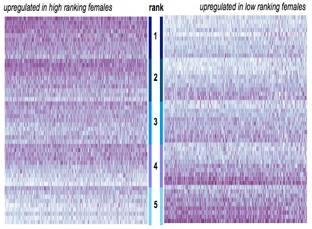Research


Our research uses genetic and genomic tools to shed light on behavioral and evolutionary questions. We are particularly interested in populations for which genetic analysis can be combined with data on the behavior, life history, and environmental milieu of known individuals. Such populations allow us to ask how behavioral and environmental patterns that influence trait variation on the level of individuals shape evolutionary outcomes on the level of populations and species. They also provide an opportunity to study the role of genes in influencing health and well-being as individuals progress through the life span.
Current research in the lab focuses on two systems:
Baboons in the Amboseli basin of Kenya
The baboons of the Amboseli basin have been the subject of ongoing study for more than four decades by the Amboseli Baboon Research Project, yielding tremendous insight into the behavior and life history of these highly social primates. We work closely with our collaborators--experts in behavioral ecology, behavioral endocrinology, and ecological immunology--to understand the links between genetic structure and functional genomics on one hand, and social behavior and demography on the other. Recently, Jenny Tung joined the project as the Associate Director for Genetics of the ABRP, and work on the Amboseli baboons constitutes the main focus of the lab.

Current research questions
-
1)How do social environmental effects influence gene regulation across the life course? The social environment is strongly shaped by maternal dominance rank and maternal social connectedness in the Amboseli baboons. These characteristics have important effects on survival, maturation, and physiology that can persist for many years. We use whole genome gene expression profiles and DNA methylation data to understand the role of these effects--both in early life and during adulthood--on the molecular level.
-
2)What is the contribution of hybridization and admixture to genetic and phenotypic variation, and by extension, to evolutionary genetic change? In the past several decades, occasional introgression by male anubis baboons (Papio anubis) has begun changing the composition of the Amboseli population (historically composed of yellow baboons, Papio cynocephalus). We have documented effects of individual admixture on mating behavior and on social and physiological maturation. Currently, we are integrating fine-grained behavioral data with genetic marker data to understand the dynamics of admixture-mediated change in Amboseli and in the larger region. We also investigate the behavioral mechanisms that promote these patterns of change.
Captive rhesus macaques at Yerkes NPRC
Rhesus macaques in captivity present the opportunity to study social environmental effects on genetics and gene regulation in a controlled setting. We take advantage of the ability to manipulate social status and social group composition to isolate the influence of these variables and to study the regulatory mechanisms that mediate these effects.

Current research questions
-
1)How do social environmental effects on immune system gene regulation vary depending on context? Different cell types play different functional roles in the immune system, even within a single tissue such as blood. We are following up on previous work demonstrating dominance rank effects on gene expression by investigating differences in sensitivity to the social environment across cell types and under conditions of immunological challenge.
-
2)What is the role of glucocorticoids and the glucocorticoid receptor in linking social stress to gene regulation? Glucocorticoid regulation is an important component of the stress response and has been the subject of extensive investigation in the behavioral literature. The glucocorticoid receptor serves as a cellular sensor for glucocorticoids, and also acts as a transcription factor. We are investigating how social stress alters GR targeting and rank-dependent effects of GCs on transcription.